 Those things go together, right?!
Those things go together, right?!
Today they do!
First, we want to announce the winners of the Eat Real t-shirts!
Thank you for such a wonderful response to last week’s coaching tip! We are so grateful for all of you and are humbled and inspired by all of your comments. So inspired, in fact, that we decided to give away FIVE t-shirts instead of THREE! Watch to see our 5 lucky winners!
If you are not able to watch the video, scroll down to the end of this coaching tip to see the winners. And, remember, if you didn’t win one, you can still order your own here.
Now, let’s talk pickles!
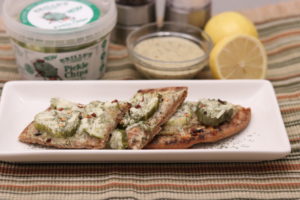 If you looked at the meal ideas we sent out last Thursday, you may have noticed our newest addition to the Eat Real America collection – a Dill Pickle Flatbread!
If you looked at the meal ideas we sent out last Thursday, you may have noticed our newest addition to the Eat Real America collection – a Dill Pickle Flatbread!
The dill pickles go perfectly with the garlic sauce that serves as the base of the flatbread – we loved it and hope you do too. And yes, pickles are a great way to activate flavor in so many meals!
Pickles are REAL food, right?
Aren’t they just cucumbers, spices and some pickling liquid?
Unfortunately, it’s not quite that simple when it comes to buying jarred pickles.
Have you ever stopped to look at the label?
A few years ago, we were looking at the labels on some jars of pickles and it stopped us in our tracks. After picking up a jar and reading the ingredients, we were stumped. What are those extra ingredients…and why is Yellow 5 in pickles? And, why in the world are they called “dill” pickles if there is no “dill” in the ingredients?
Yes, even pickles have artificial ingredients added, with the most concerning one being Yellow 5. We have seen this artificial color offender in breakfast cereals like Lucky Charms, chips like Doritos, and in drinks like Gatorade and Mountain Dew, but pickles too?
How are pickles made?
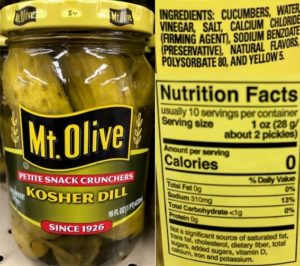 Pickles are typically processed with vinegar, water and salt — this is how cucumbers are transformed into what we all know as “pickles.” Actually, you can “pickle” a wide variety of vegetables (asparagus, carrots, cauliflower, okra, radishes, red onions…just to name a few), but the word “pickle” is most often associated with pickled cucumbers.
Pickles are typically processed with vinegar, water and salt — this is how cucumbers are transformed into what we all know as “pickles.” Actually, you can “pickle” a wide variety of vegetables (asparagus, carrots, cauliflower, okra, radishes, red onions…just to name a few), but the word “pickle” is most often associated with pickled cucumbers.
Industrial-jarred pickles can lose their color during the production process…they may even turn gray (appetizing, right?!)! So, to create a standardized product and overcome these effects, manufacturers often add color. There are natural food dyes such as turmeric or paprika, but artificial food dyes like Yellow 5 are brighter, cheaper and more stable — they can remain vibrant for years! Which is a quality we all look for in pickles…for them to last for “years?!”
What is Yellow 5?
 Yellow 5, also known as tartrazine, is an artificial food dye that has been linked to adverse health effects such as hyperactivity, asthma, skin rashes, migraines, and even cancer. In Europe, warning labels are required on products containing Yellow 5 and at least a couple countries have banned it altogether.
Yellow 5, also known as tartrazine, is an artificial food dye that has been linked to adverse health effects such as hyperactivity, asthma, skin rashes, migraines, and even cancer. In Europe, warning labels are required on products containing Yellow 5 and at least a couple countries have banned it altogether.
It is found in all kinds of foods like chips, crackers, cereal, salad dressings, cakes, puddings, cookies, muffins and bread, and also in some medications, cosmetics and various household products.
Studies have shown different results regarding the health effects of Yellow 5, and there are several studies that have raised a red flag on the long-term health effects for conditions like hyperactivity and cancer.
So, what can we do?
You can find options at the store and farmers’ market that don’t contain added coloring or preservatives — as we always say…read those ingredient labels!
2. DIY!
You knew this was coming! Make your own homemade pickles!
It really is easier than you think to make your own homemade pickles (or other pickled vegetables)! And, they taste great — what a great learning opportunity for kids!
- Typical homemade dill pickles need to sit in the refrigerator for 2-3 days to let them “pickle.” Try our Homemade Garlic Dill Pickles – delicious and addicting!
- For a faster pickling version, try quick pickling and they will be ready to enjoy in as little as one hour. This is our favorite way to enjoy pickled veggies for tacos, salads and burgers. You can even use your favorite beer (like an IPA) for a unique spin on pickled veggies. We admit, we can be impatient…we really love the quick pickling method! And it works great for cucumbers!
 Get creative and pickle a variety of veggies such as asparagus, peppers, onions, carrots, radishes, and then add garlic cloves and fresh herbs — get as creative as you want!
Get creative and pickle a variety of veggies such as asparagus, peppers, onions, carrots, radishes, and then add garlic cloves and fresh herbs — get as creative as you want!
Do you make your own pickles, or pickled veggies?
And what is your favorite way to enjoy them?
Our 5 lucky Eat REAL t-shirt winners are Michelle Armstrong, Susan Sabourin, Janet Shapic, Lisa Kassel and Ruth Pinter. Congratulations, we will be in touch!

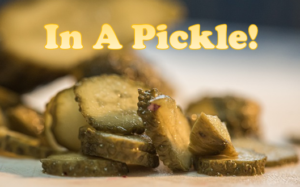
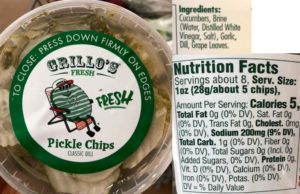
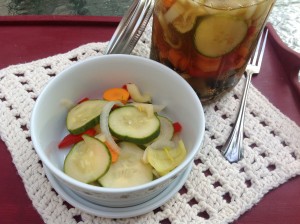
We love dill pickles and are always on the lookout for a healthier version. Recently we found Suckerpunch Gourmet Garlic Dill Spears in the specialty aisle at Aldis. The sodium is still a little high at 230mg per spear but otherwise there are no risky additives and they taste great.
Thank you for the heads up – like you, we are always on the lookout for convenient options! We appreciate you!
I made my own pickles this past fall both dill and bread and butter. Yum and easy!
I’m SO excited that I was one of the t-shirt winners! My email address is: scsabourin@yahoo.com
I look forward to hearing from you. Thanks so much!
We’ve found Old World Polish Dill Pickles at Menards of all places! They taste great and have only 90 grams of sodium and 1g of added sugar per pickle! No HFCS, no preservatives, no GMOs. My Yuka app rates them excellent–90/100!